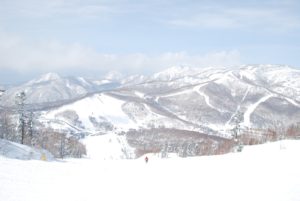 Saturday, March 25 is our last day at Hotel Khuls in Ichinose area, Shiga Kogen ski resort. It has been a grand time! John is torn between staying another night and going back because the snow is so awesome and he’s having such a great time. Halyard went home yesterday so we asked him to take a taxi and pick up the cats at the pet hotel and bring them home. So really, there’s nothing stopping us from another night away.
Saturday, March 25 is our last day at Hotel Khuls in Ichinose area, Shiga Kogen ski resort. It has been a grand time! John is torn between staying another night and going back because the snow is so awesome and he’s having such a great time. Halyard went home yesterday so we asked him to take a taxi and pick up the cats at the pet hotel and bring them home. So really, there’s nothing stopping us from another night away.
One last delicious breakfast. The food has been plentiful and yummy during our entire stay. Some internet reviews complained about the selection but we (all 17 of us) thought it was terrific. John and I and the kids decided to ski all morning and then try to catch the 12:05 express bus back to Nagano Station.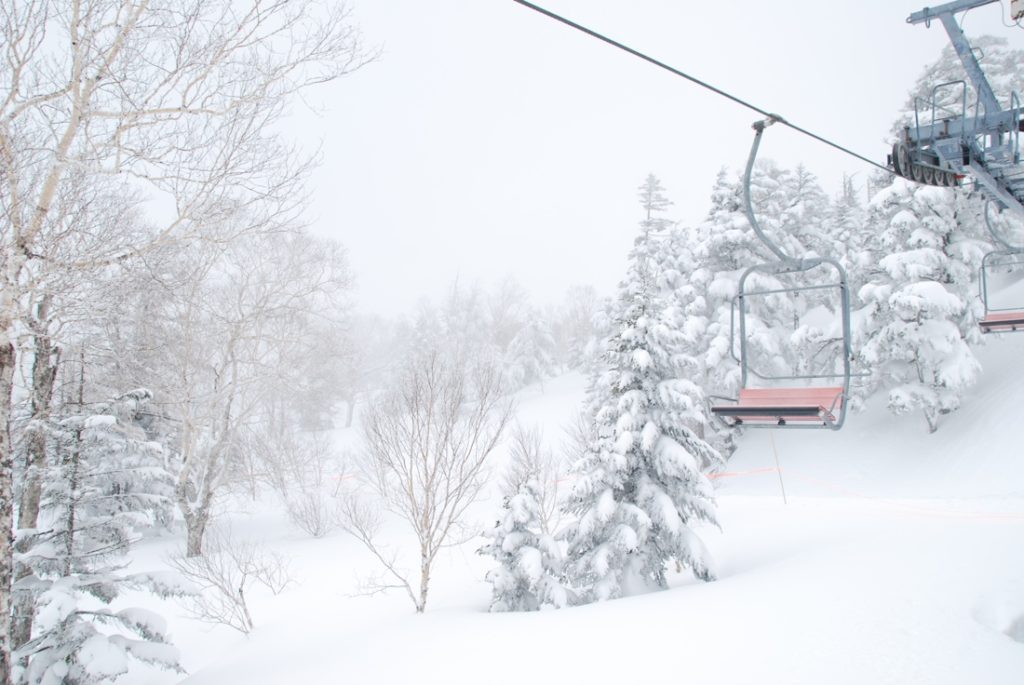 The powder was wonderful again. John was on a mission to get to the Olympic course, which was used for the giant slalom events in the 1998 Winter Olympics in the Higashiyama area. We knew this was near the egg shaped gondola called the Higashi Tateyama Gondola. We discovered there is a choice to ski down the Olympic run, or a gentle and scenic winding course through trees. The Olympic course is an intermediate run and very long. The kids had no problem coming down it, but Avalon said she didn’t like it.
The powder was wonderful again. John was on a mission to get to the Olympic course, which was used for the giant slalom events in the 1998 Winter Olympics in the Higashiyama area. We knew this was near the egg shaped gondola called the Higashi Tateyama Gondola. We discovered there is a choice to ski down the Olympic run, or a gentle and scenic winding course through trees. The Olympic course is an intermediate run and very long. The kids had no problem coming down it, but Avalon said she didn’t like it.
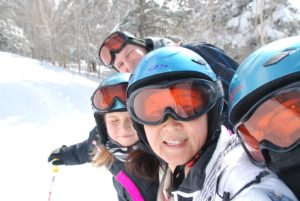 After we skied this area and rode the gondola a few times Avalon and Kaiyo wanted to go down the scenic and winding path through the trees so John and I split off. I thought our two paths were going to meet again at a certain chairlift but the kids didn’t show up. Then we got a call from Kaiyo. He said Avalon had skied on ahead and now he could not find her. John and I told him to wait for us at the gondola. We found Kaiyo and retraced his last ski run where he’d lost track of Avalon. No sign of her. We went on the run again. We waited at the gondola. Still no sign of her. She didn’t have her phone with her either. We took some different off shoots from various paths but still went back to the gondola. No sign of Avalon. Ugh! It was already 12 noon so we were obviously not going to make the 12:05 express bus back to Nagano Station.
After we skied this area and rode the gondola a few times Avalon and Kaiyo wanted to go down the scenic and winding path through the trees so John and I split off. I thought our two paths were going to meet again at a certain chairlift but the kids didn’t show up. Then we got a call from Kaiyo. He said Avalon had skied on ahead and now he could not find her. John and I told him to wait for us at the gondola. We found Kaiyo and retraced his last ski run where he’d lost track of Avalon. No sign of her. We went on the run again. We waited at the gondola. Still no sign of her. She didn’t have her phone with her either. We took some different off shoots from various paths but still went back to the gondola. No sign of Avalon. Ugh! It was already 12 noon so we were obviously not going to make the 12:05 express bus back to Nagano Station.
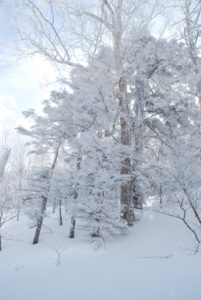 Finally John left on a side path that looked pretty tricky but we still hadn’t seen her anywhere so he wanted to look there. I said there’s no way she went that way. Kaiyo and I went back up the gondola and skied back to the hotel. I figured eventually she would go back there. We probably searched for her for an hour and a half. When I finally made it back to the hotel she was there at the front desk trying to call me. She said she had just made it back. Phew! According to Avalon she went on the gondola three times, down the same paths we were looking for her and on the Olympic course looking for us. I said we were doing the same thing! She should have stayed put at the gondola! Well, all’s well that ends well.
Finally John left on a side path that looked pretty tricky but we still hadn’t seen her anywhere so he wanted to look there. I said there’s no way she went that way. Kaiyo and I went back up the gondola and skied back to the hotel. I figured eventually she would go back there. We probably searched for her for an hour and a half. When I finally made it back to the hotel she was there at the front desk trying to call me. She said she had just made it back. Phew! According to Avalon she went on the gondola three times, down the same paths we were looking for her and on the Olympic course looking for us. I said we were doing the same thing! She should have stayed put at the gondola! Well, all’s well that ends well.
We ate lunch and got the 2:15 express bus to Nagano Station. It was over an hour trip so I think we all fell asleep. At the station I wanted to walk around and look for manhole covers. So we put our bags in the coin lockers and went exploring. Here are some fun manhole covers in Nagano. And I already posted a photo of the manhole with the design from the winter olympics, but here it is again.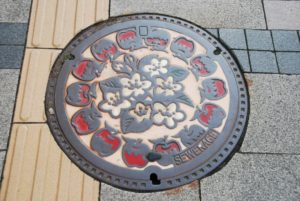
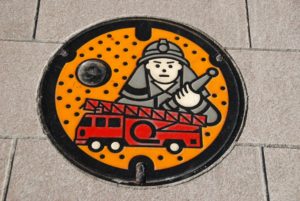

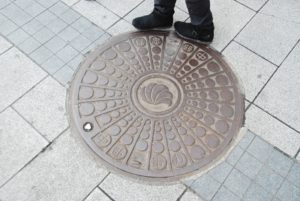 I wanted to make a stop in Matsumoto on the way home, to see the historic castle there. It’s only one hour from Nagano Station. On the train I found a place to stay overnight from the Trip Advisor website. It was slim pickings. We stayed at Gosanso, a small, traditional, family-run ryokan. It was about 15800 yen (that comes to around $40 per person) for the night. John said the bath was cold! We found dinner at a restaurant that was decorated like a mountain lodge and it was playing loud American music from the 60s-70s like Joni Mitchell, The Carpenters, Elton John, Steely Dan. After that we walked to Matsumoto Castle to see it lit up at night.
I wanted to make a stop in Matsumoto on the way home, to see the historic castle there. It’s only one hour from Nagano Station. On the train I found a place to stay overnight from the Trip Advisor website. It was slim pickings. We stayed at Gosanso, a small, traditional, family-run ryokan. It was about 15800 yen (that comes to around $40 per person) for the night. John said the bath was cold! We found dinner at a restaurant that was decorated like a mountain lodge and it was playing loud American music from the 60s-70s like Joni Mitchell, The Carpenters, Elton John, Steely Dan. After that we walked to Matsumoto Castle to see it lit up at night. In the morning it was snowing big white fluffy flakes! We hadn’t ordered breakfast in advance so when John tried to ask if we could order it in the morning they said no it was too late. But the ryokan owner tried to give John a bag of rolls instead. John politely declined. We took a cab to Matsumoto Station to put the rest of our overnight bags in lockers. Then we ate breakfast and set back out for the castle to see it in daylight.
In the morning it was snowing big white fluffy flakes! We hadn’t ordered breakfast in advance so when John tried to ask if we could order it in the morning they said no it was too late. But the ryokan owner tried to give John a bag of rolls instead. John politely declined. We took a cab to Matsumoto Station to put the rest of our overnight bags in lockers. Then we ate breakfast and set back out for the castle to see it in daylight.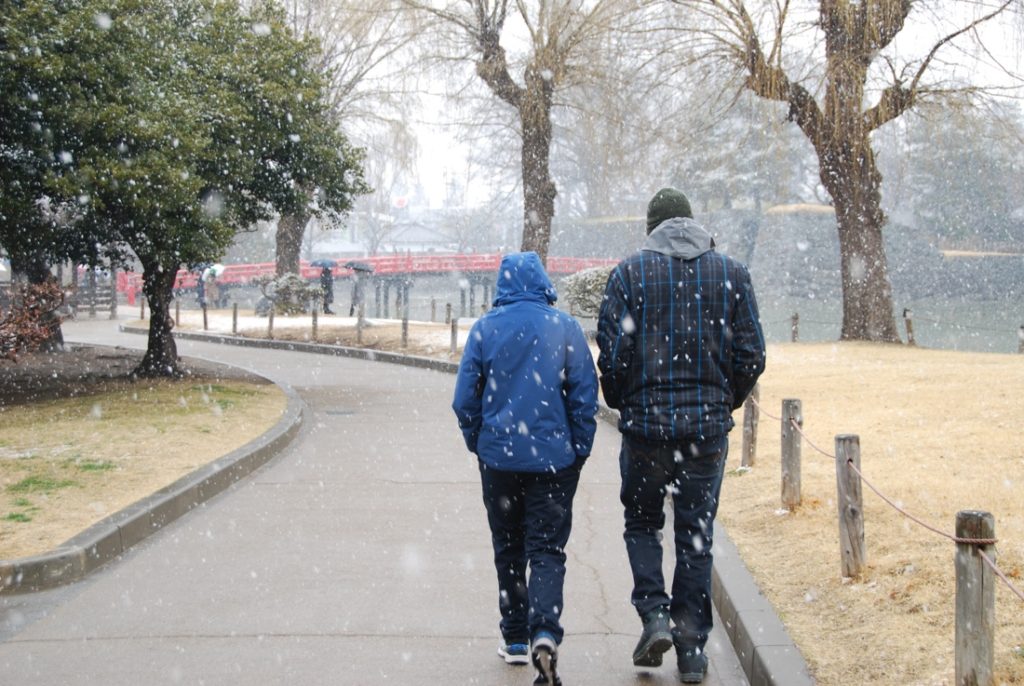 Matsumoto Castle, or Matsumoto-Jo, with Jo meaning Castle, is 400 years old. It is also known as Crow Castle for its black exterior. It is one of five castles listed as a National Treasure of Japan. Many people argue that this is one of the top castles in Japan, just behind the imposing Himeji-Jo (also known as White Heron Castle for its while exterior) outside of Osaka.
Matsumoto Castle, or Matsumoto-Jo, with Jo meaning Castle, is 400 years old. It is also known as Crow Castle for its black exterior. It is one of five castles listed as a National Treasure of Japan. Many people argue that this is one of the top castles in Japan, just behind the imposing Himeji-Jo (also known as White Heron Castle for its while exterior) outside of Osaka.
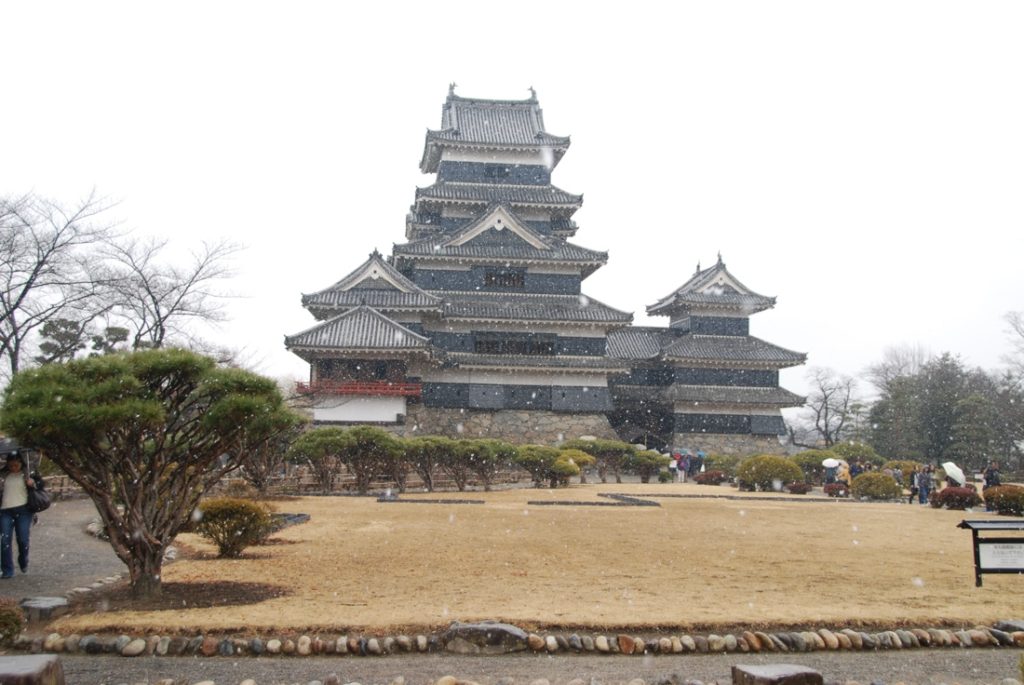 Matsumoto Castle is unique because it is a flatland castle (hirajiro). It is not built on a mountainside or hilltop or amid rivers, but on a plain. The most interesting part of the castle is the main donjon (or castle keep) completed in the late 16th century, and which maintains its original wooden interiors and external stonework. This castle is not a replica like most other castles in Japan.
Matsumoto Castle is unique because it is a flatland castle (hirajiro). It is not built on a mountainside or hilltop or amid rivers, but on a plain. The most interesting part of the castle is the main donjon (or castle keep) completed in the late 16th century, and which maintains its original wooden interiors and external stonework. This castle is not a replica like most other castles in Japan.
The website, http://myoko-nagano.com/matsumoto-castle says:
“To enter you first pass through a separate minor keep called Inui Kotenshu (because it stands inui or northwest of the main tower) that from the outside appears to have three stories but actually has four, the hidden floor concealing defences. Round wooden pillars, rough hewn by a hand tool shaped like an axe (the entire castle being made by impressed labour) from hemlock, spruce and fir trees. There are 10 round pillars supporting the 1st and 2nd floors, 12 pillars support the upper floors.
“The second floor of the main keep features a gun museum, Teppo Gura, with a collection of guns, armor and other weapons. All of the guns, armor and other weapons were the personal collection of Akahane Michishige, a local citizen, who built the collection with his wife Kayoko over a period of more than 30 years. The collection was donated to the city in 1991.”
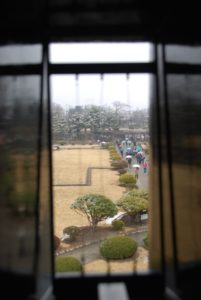 The architecture and defense design of this castle was so intriguing. A castle’s main duty is to protect it from enemy attack. The things that I found most impressive were the archers’ windows (called yazama, shown here) for shooting arrows at the enemy, the firearms windows (called teppozama) for firing weapons after muskets were introduced in Japan and openings in the floor to drop stones on enemies trying to scale the castle’s stone walls (known as ishigaki). These floor openings are called ishiotoshi and I can just imagine ninjas, dressed in black, trying to scale the stone wall at midnight, only to have surprise boulders raining down as they get close.
The architecture and defense design of this castle was so intriguing. A castle’s main duty is to protect it from enemy attack. The things that I found most impressive were the archers’ windows (called yazama, shown here) for shooting arrows at the enemy, the firearms windows (called teppozama) for firing weapons after muskets were introduced in Japan and openings in the floor to drop stones on enemies trying to scale the castle’s stone walls (known as ishigaki). These floor openings are called ishiotoshi and I can just imagine ninjas, dressed in black, trying to scale the stone wall at midnight, only to have surprise boulders raining down as they get close.
There is a dark room here that is the safest part of the castle because it cannot be seen from the outside. The warriors stayed here during wartime. There was also a fairly wide landing running along the perimeter of the dark room, to allow warriors to run around the castle floor in their massive uniforms of metal and weapons.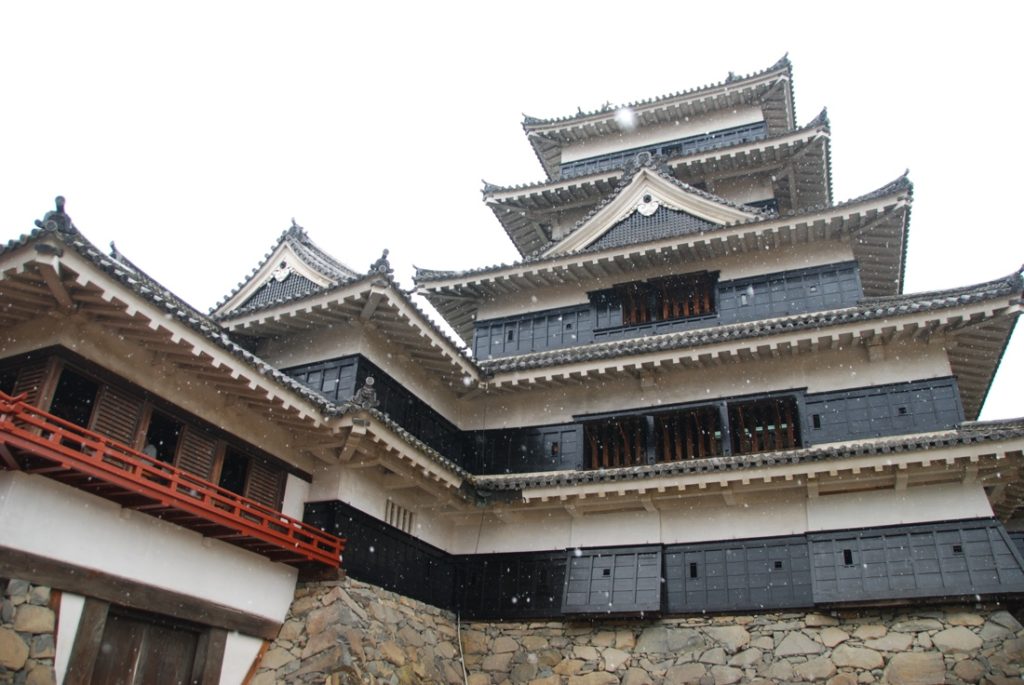 One area is called the Tsukimi-yagura, shown here on the left with the red balustrades around the verandah. This is the “moon observatory turret.” It was attached on to the main castle keep in times of peace. Tsukimi, or Moon Viewing parties were celebrated from the Heian period, traditionally on the 15th day of the 8th month and the 13th day of the 9th month by the old Japanese solar calendar.
One area is called the Tsukimi-yagura, shown here on the left with the red balustrades around the verandah. This is the “moon observatory turret.” It was attached on to the main castle keep in times of peace. Tsukimi, or Moon Viewing parties were celebrated from the Heian period, traditionally on the 15th day of the 8th month and the 13th day of the 9th month by the old Japanese solar calendar.
And the stairs in this castle are so steep and vertical they are almost ladders. When we entered the castle we had to take off our shoes and put on slippers. When I went up and down the steepest steps I had to take off the slippers and hold them in my hand, lest they fall off my feet! The stairway was so narrow that it was hard to have people going up and down at the same time. I can’t imagine that warriors in full armor went up or down these stairs. Or even ladies in tight, unbreathable kimonos. I think such stairs must have been only for the lords of the castle if they were skinny.
 We stayed here for a few hours before moving on. I think the City of Matsumoto enjoys a frog theme.
We stayed here for a few hours before moving on. I think the City of Matsumoto enjoys a frog theme.
Here are some katana-wielding samurai frogs! The third frog with the highest raised katana is behind Kaiyo.
We walked to a quaint street called Nawate-dori (this is where we had dinner last night as well) with a lot of small shops, cafes and small restaurants. And a lot of frogs, too! Statues tall and small of frogs, plus pictures, souvenirs and frog themed signs lined this street. I guess Nawate-dori might also be known as frog street.
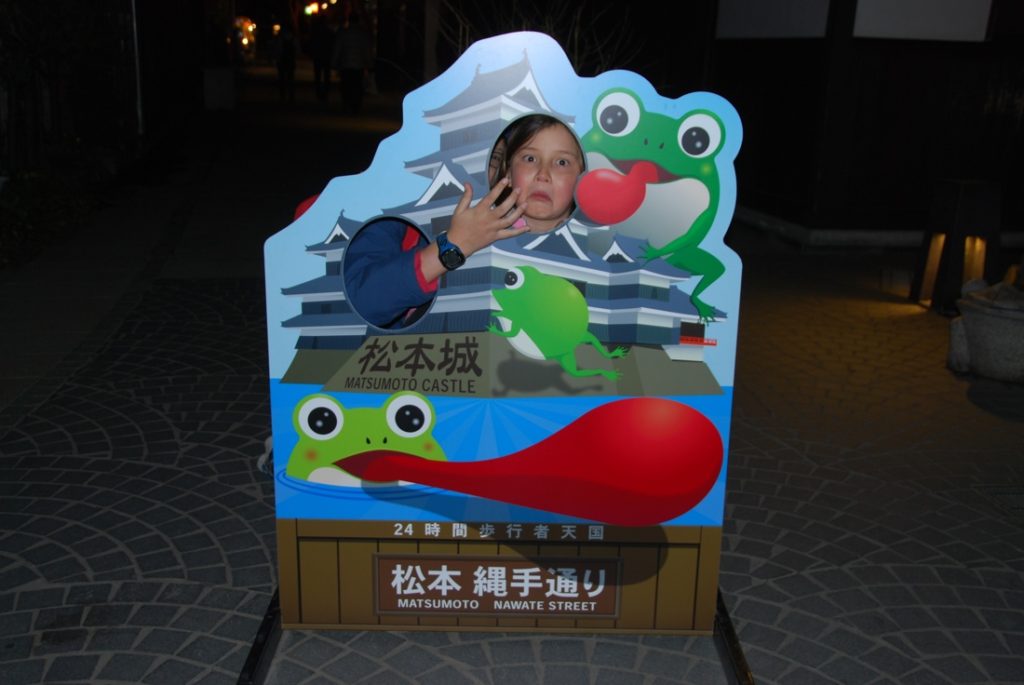 I love the awesome manhole covers in Matsumoto City. They depict a symbol of the city: temari. You can see pictures and likeness of temari everywhere. Here is some history from www.go-nagano.net:
I love the awesome manhole covers in Matsumoto City. They depict a symbol of the city: temari. You can see pictures and likeness of temari everywhere. Here is some history from www.go-nagano.net:
“Matsumoto’s most well-known folk craft: colorful “temari” handballs made with bits of yarn. Winding the silk threads into the intricate patterns takes 4 to 5 hours for each ball. In the early Showa Era years, the white with red, yellow and purple temari balls were children’s toys, but nowadays they are mainly used as gifts and interior decorations.”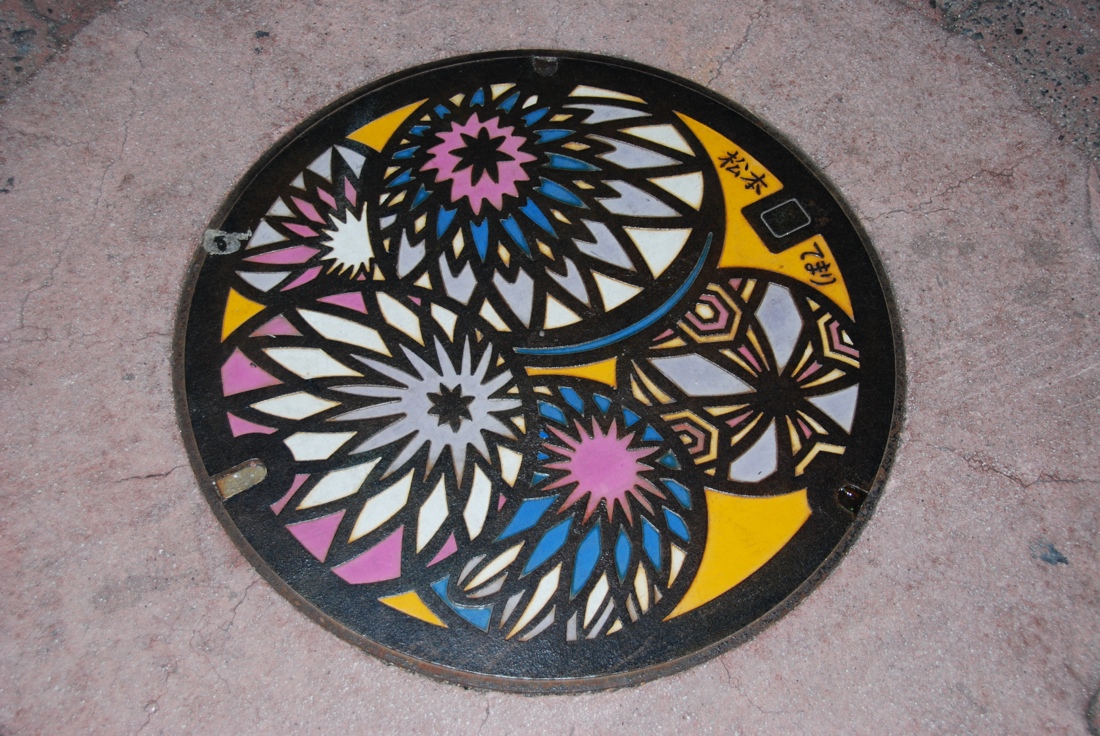
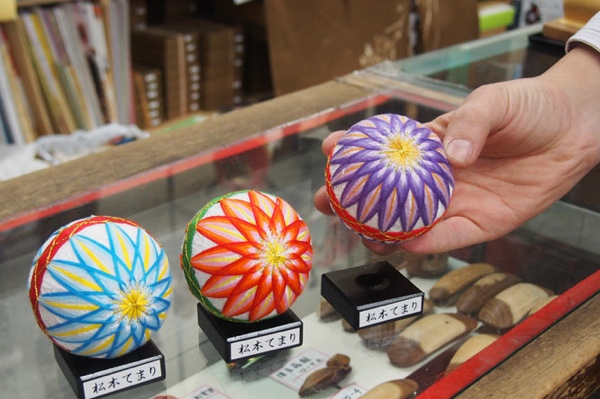
I can’t remember if this is in Nagano or Matsumoto! Either way, it is somewhere over there yonder in the mountain towns. And yes, Avalon knows the cat is licking her hair.
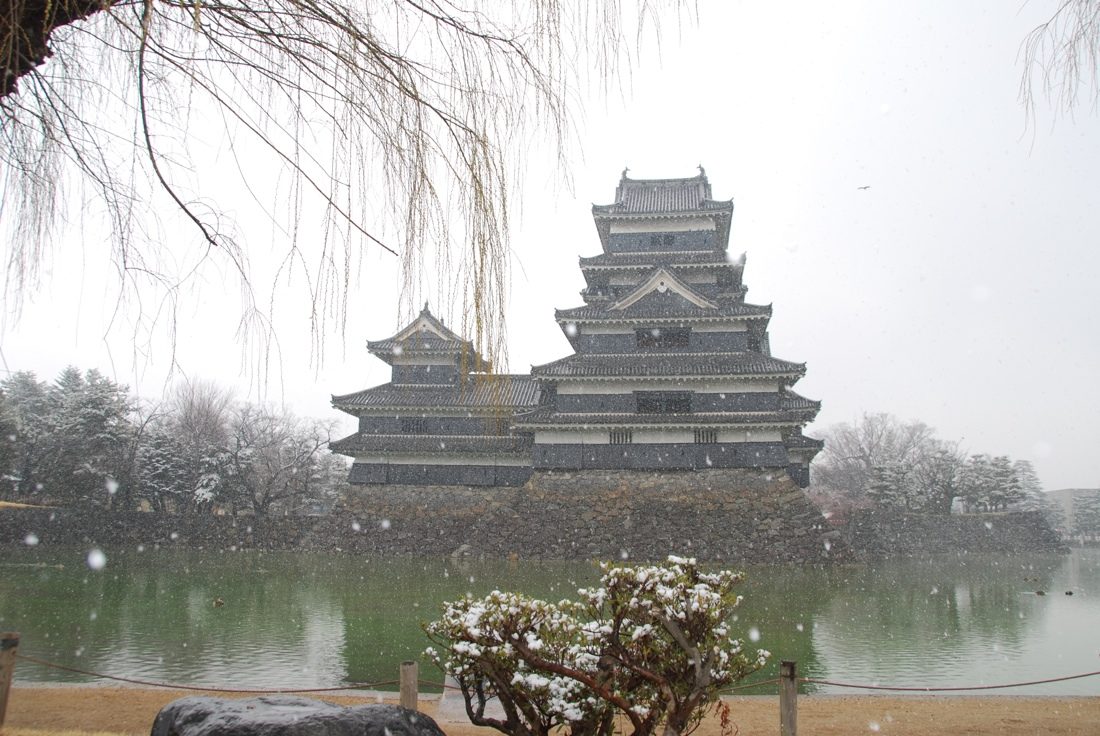
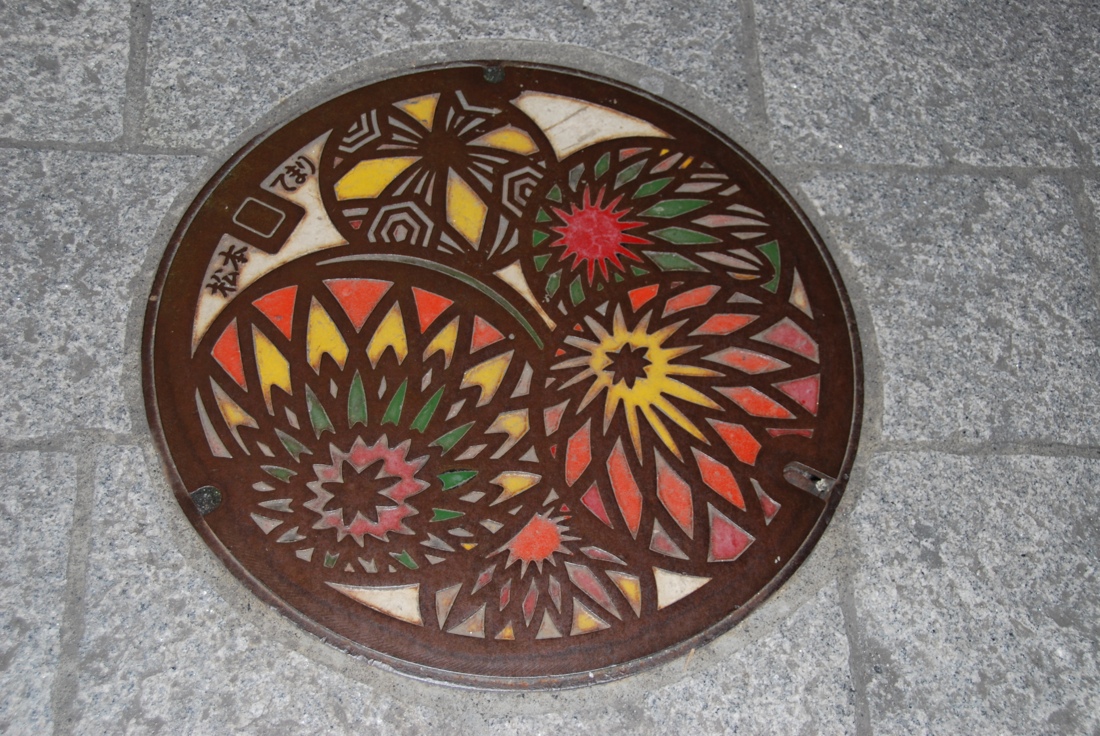
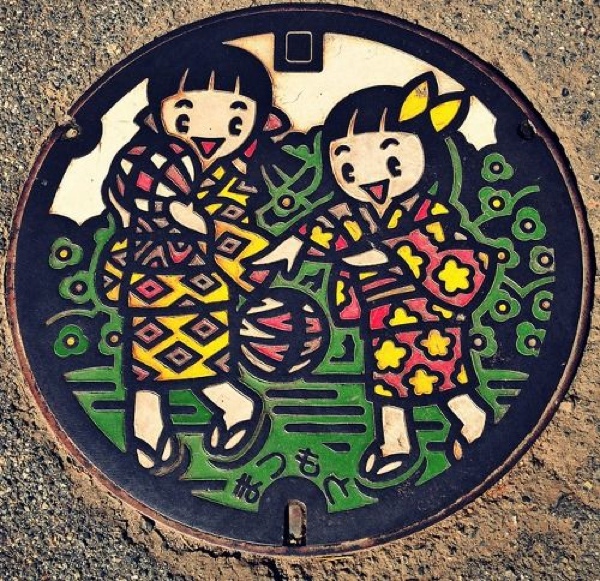
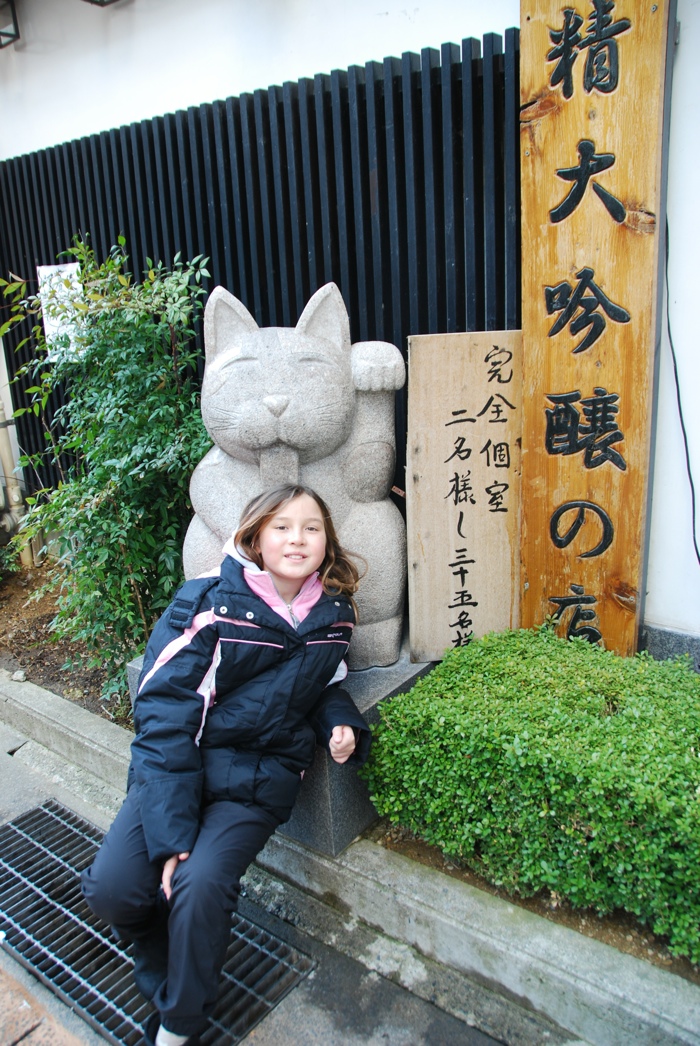
Comments (0)